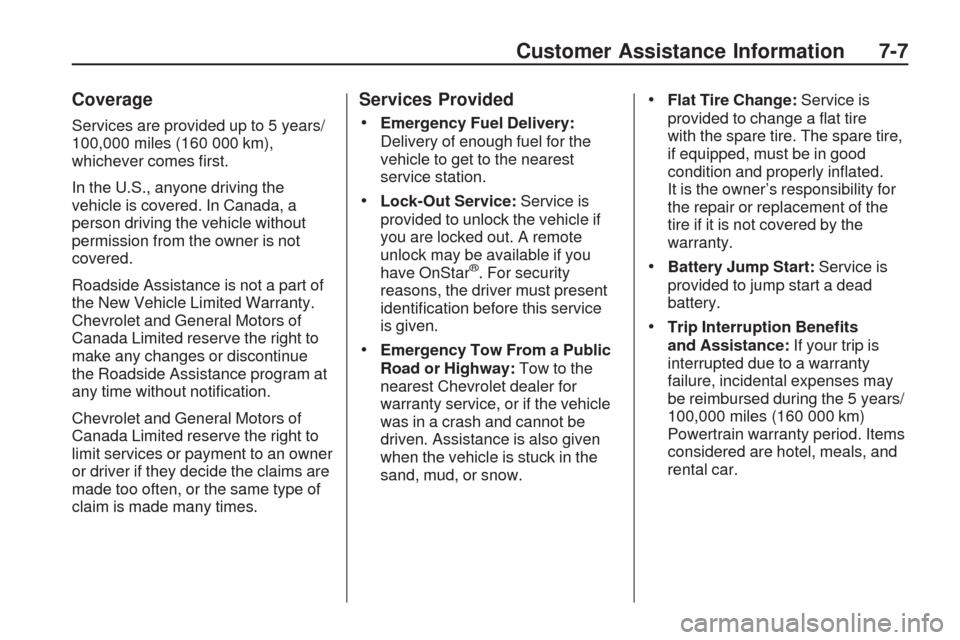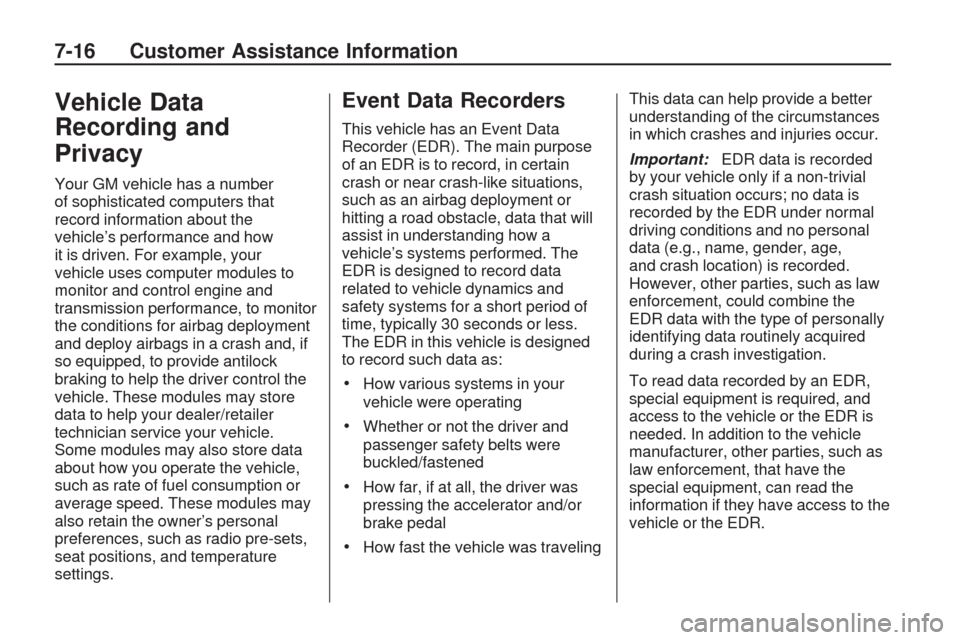2009 CHEVROLET TRAVERSE fuel type
[x] Cancel search: fuel typePage 286 of 422

California Proposition 65
Warning
Most motor vehicles, including this
one, contain and/or emit chemicals
known to the State of California
to cause cancer and birth defects or
other reproductive harm. Engine
exhaust, many parts and systems
(including some inside the vehicle),
many �uids, and some component
wear by-products contain and/or
emit these chemicals.
California Perchlorate
Materials Requirements
Certain types of automotive
applications, such as airbag
initiators, seat belt pretensioners,
and lithium batteries contained in
remote keyless transmitters, may
contain perchlorate materials.
Special handling may be necessary.
For additional information, see
www.dtsc.ca.gov/hazardouswaste/
perchlorate.
Doing Your Own
Service Work
{CAUTION
You can be injured and the
vehicle could be damaged if you
try to do service work on a vehicle
without knowing enough about it.
Be sure you have sufficient
knowledge, experience, the
proper replacement parts, and
tools before attempting any
vehicle maintenance task.
Be sure to use the proper
nuts, bolts, and other
fasteners. English and metric
fasteners can be easily
confused. If the wrong
fasteners are used, parts
can later break or fall off.
You could be hurt.
If doing some of your own service
work, use the proper service
manual. It tells you much moreabout how to service the vehicle
than this manual can. To order the
proper service manual, see
Service Publications Ordering
Information on page 7-15.
This vehicle has an airbag system.
Before attempting to do your
own service work, seeServicing
Your Airbag-Equipped Vehicle
on page 1-57.
Keep a record with all parts receipts
and list the mileage and the date
of any service work performed. See
Maintenance Record on page 6-16.Adding Equipment to the
Outside of the Vehicle
Things added to the outside of
the vehicle can affect the air�ow
around it. This can cause wind noise
and can affect fuel economy and
windshield washer performance.
Check with your dealer/retailer
before adding equipment to
the outside of the vehicle.
5-4 Service and Appearance Care
Page 287 of 422

Fuel
Use of the recommended fuel
is an important part of the proper
maintenance of this vehicle. To help
keep the engine clean and maintain
optimum vehicle performance, we
recommend the use of gasoline
advertised as TOP TIER Detergent
Gasoline.
Gasoline Octane
Use regular unleaded gasoline with a
posted octane rating of 87 or higher.
If the octane rating is less than 87,
you might notice an audible knocking
noise when you drive, commonly
referred to as spark knock. If this
occurs, use a gasoline rated at
87 octane or higher as soon as
possible. If you are using gasoline
rated at 87 octane or higher and you
hear heavy knocking, the engine
needs service.
Gasoline Speci�cations
At a minimum, gasoline should
meet ASTM speci�cation D 4814
in the United States or CAN/
CGSB-3.5 or 3.511 in Canada.
Some gasolines contain an
octane-enhancing additive called
methylcyclopentadienyl manganese
tricarbonyl (MMT). We recommend
against the use of gasolines
containing MMT. SeeAdditives on
page 5-5for additional information.
California Fuel
If the vehicle is certi�ed to meet
California Emissions Standards,
it is designed to operate on fuels
that meet California speci�cations.
See the underhood emission control
label. If this fuel is not available in
states adopting California emissions
standards, the vehicle will operate
satisfactorily on fuels meeting federal
speci�cations, but emission control
system performance might be
affected. The malfunction indicator
lamp could turn on and the vehiclemight fail a smog-check test. See
Malfunction Indicator Lamp on
page 3-39. If this occurs, return to
your authorized dealer/retailer for
diagnosis. If it is determined that the
condition is caused by the type of
fuel used, repairs might not be
covered by the vehicle warranty.
Additives
To provide cleaner air, all gasolines
in the United States are now required
to contain additives that help prevent
engine and fuel system deposits
from forming, allowing the emission
control system to work properly.
In most cases, you should not have
to add anything to the fuel. However,
some gasolines contain only the
minimum amount of additive required
to meet U.S. Environmental
Protection Agency regulations.
To help keep fuel injectors and
intake valves clean, or if the vehicle
experiences problems due to dirty
injectors or valves, look for gasoline
that is advertised as TOP TIER
Detergent Gasoline.
Service and Appearance Care 5-5
Page 290 of 422

The diagnostic system can
determine if the fuel cap has been
left off or improperly installed. This
would allow fuel to evaporate into the
atmosphere. SeeMalfunction
Indicator Lamp on page 3-39.
If the vehicle has a Driver Information
Center (DIC), the TIGHTEN GAS
CAP message displays if the fuel cap
is not properly installed.
{CAUTION
If a �re starts while you are
refueling, do not remove the
nozzle. Shut off the �ow of fuel by
shutting off the pump or by
notifying the station attendant.
Leave the area immediately.Notice:If you need a new fuel
cap, be sure to get the right type.
Your dealer/retailer can get one for
you. If you get the wrong type, it
might not �t properly. This can
cause the malfunction indicator
lamp to light and can damage the
fuel tank and emissions system.
SeeMalfunction Indicator Lamp
on page 3-39.
Filling a Portable Fuel
Container
{CAUTION
Never �ll a portable fuel container
while it is in the vehicle. Static
electricity discharge from the
container can ignite the fuel vapor.
(Continued)
CAUTION (Continued)
You can be badly burned and the
vehicle damaged if this occurs. To
help avoid injury to you and others:
Dispense fuel only into
approved containers.
Do not �ll a container while it
is inside a vehicle, in a
vehicle’s trunk, pickup bed, or
on any surface other than the
ground.
Bring the �ll nozzle in contact
with the inside of the �ll
opening before operating the
nozzle. Contact should be
maintained until the �lling is
complete.
Do not smoke while
pumping fuel.
Do not use a cellular phone
while pumping fuel.
5-8 Service and Appearance Care
Page 399 of 422

Coverage
Services are provided up to 5 years/
100,000 miles (160 000 km),
whichever comes �rst.
In the U.S., anyone driving the
vehicle is covered. In Canada, a
person driving the vehicle without
permission from the owner is not
covered.
Roadside Assistance is not a part of
the New Vehicle Limited Warranty.
Chevrolet and General Motors of
Canada Limited reserve the right to
make any changes or discontinue
the Roadside Assistance program at
any time without noti�cation.
Chevrolet and General Motors of
Canada Limited reserve the right to
limit services or payment to an owner
or driver if they decide the claims are
made too often, or the same type of
claim is made many times.
Services Provided
Emergency Fuel Delivery:
Delivery of enough fuel for the
vehicle to get to the nearest
service station.
Lock-Out Service:Service is
provided to unlock the vehicle if
you are locked out. A remote
unlock may be available if you
have OnStar
®. For security
reasons, the driver must present
identi�cation before this service
is given.
Emergency Tow From a Public
Road or Highway:Tow to the
nearest Chevrolet dealer for
warranty service, or if the vehicle
was in a crash and cannot be
driven. Assistance is also given
when the vehicle is stuck in the
sand, mud, or snow.
Flat Tire Change:Service is
provided to change a �at tire
with the spare tire. The spare tire,
if equipped, must be in good
condition and properly in�ated.
It is the owner’s responsibility for
the repair or replacement of the
tire if it is not covered by the
warranty.
Battery Jump Start:Service is
provided to jump start a dead
battery.
Trip Interruption Bene�ts
and Assistance:If your trip is
interrupted due to a warranty
failure, incidental expenses may
be reimbursed during the 5 years/
100,000 miles (160 000 km)
Powertrain warranty period. Items
considered are hotel, meals, and
rental car.
Customer Assistance Information 7-7
Page 408 of 422

Vehicle Data
Recording and
Privacy
Your GM vehicle has a number
of sophisticated computers that
record information about the
vehicle’s performance and how
it is driven. For example, your
vehicle uses computer modules to
monitor and control engine and
transmission performance, to monitor
the conditions for airbag deployment
and deploy airbags in a crash and, if
so equipped, to provide antilock
braking to help the driver control the
vehicle. These modules may store
data to help your dealer/retailer
technician service your vehicle.
Some modules may also store data
about how you operate the vehicle,
such as rate of fuel consumption or
average speed. These modules may
also retain the owner’s personal
preferences, such as radio pre-sets,
seat positions, and temperature
settings.
Event Data Recorders
This vehicle has an Event Data
Recorder (EDR). The main purpose
of an EDR is to record, in certain
crash or near crash-like situations,
such as an airbag deployment or
hitting a road obstacle, data that will
assist in understanding how a
vehicle’s systems performed. The
EDR is designed to record data
related to vehicle dynamics and
safety systems for a short period of
time, typically 30 seconds or less.
The EDR in this vehicle is designed
to record such data as:
How various systems in your
vehicle were operating
Whether or not the driver and
passenger safety belts were
buckled/fastened
How far, if at all, the driver was
pressing the accelerator and/or
brake pedal
How fast the vehicle was travelingThis data can help provide a better
understanding of the circumstances
in which crashes and injuries occur.
Important:EDR data is recorded
by your vehicle only if a non-trivial
crash situation occurs; no data is
recorded by the EDR under normal
driving conditions and no personal
data (e.g., name, gender, age,
and crash location) is recorded.
However, other parties, such as law
enforcement, could combine the
EDR data with the type of personally
identifying data routinely acquired
during a crash investigation.
To read data recorded by an EDR,
special equipment is required, and
access to the vehicle or the EDR is
needed. In addition to the vehicle
manufacturer, other parties, such as
law enforcement, that have the
special equipment, can read the
information if they have access to the
vehicle or the EDR.
7-16 Customer Assistance Information